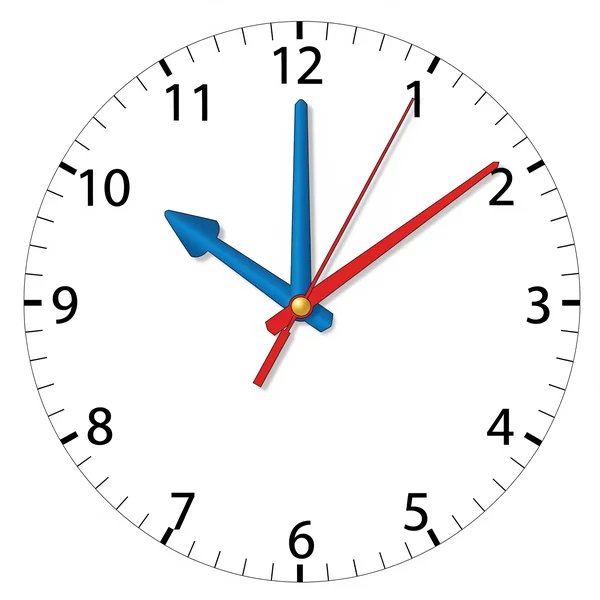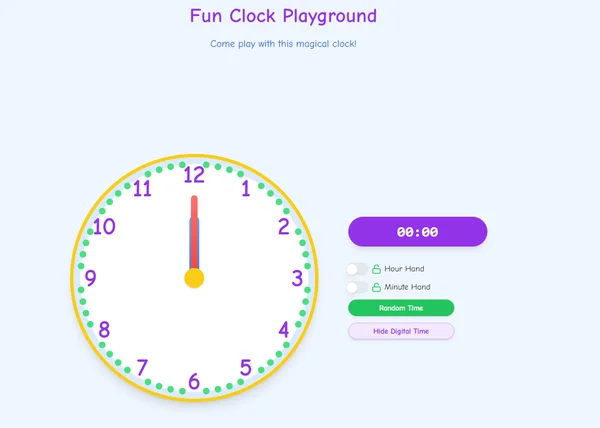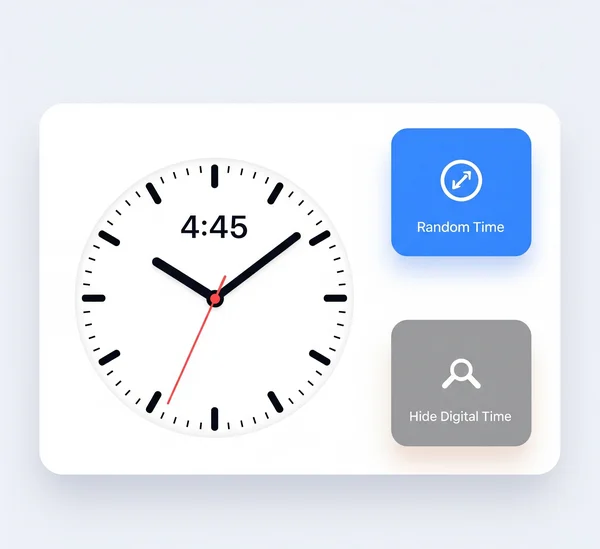Teach Kids to Tell Time: A Parent's Fun Guide
Are you a parent struggling to teach kids to tell time using an analog clock? How do you explain the hour and minute hand to a child effectively without it feeling like a chore? It can seem overwhelming, but mastering time doesn't have to be a source of frustration. Imagine turning a challenging learning task into an exciting game your child loves! This guide will share fun, easy, and effective strategies, combined with our powerful online tool, to make time-telling an exciting adventure. Ready for an exciting adventure into time-telling? Explore our Interactive Clock now!

Laying the Foundation: Understanding Analog Clocks
Before your child can confidently read an analog clock, a solid understanding of its basic components is essential. This foundational knowledge builds confidence and makes the learning process smoother and more enjoyable. It's all about making learning click!
What is an Analog Clock? A Simple Explanation for Kids
An analog clock is like a picture of time. Instead of showing numbers in a straight line (like on a digital watch), it has a round face with numbers from 1 to 12. Two special "hands" move around this circle to show us the time. Learning with an educational clock helps visualize these movements. It’s a classic way to understand time.
Explaining Hour and Minute Hands
The secret to reading an analog clock lies in understanding its two main pointers: the hour hand and the minute hand. These two hands are the keys to reading the clock: the hour hand and the minute hand.
- The Blue Hour Hand: This is the shorter, often thicker, pointer. It moves slowly and points to the numbers that tell us the hour. When the blue hour hand is pointing close to the '3', it means it's around 3 o'clock.
- The Red Minute Hand: This is the longer, thinner pointer. It moves faster than the hour hand and points to the marks or numbers that tell us the minutes past the hour. When the red minute hand is pointing to the '12', it means it's exactly on the hour.
Using clear, consistent language like "blue hour hand" and "red minute hand" helps children differentiate them easily.

Step-by-Step: How to Read an Analog Clock for Kids
Teaching your child how to read an analog clock step by step breaks down a big task into manageable pieces. Here’s a simple guide to follow:
- Find the Hour: First, look at the blue hour hand. Which number is it pointing to, or has it just passed? That’s your hour!
- Count the Minutes: Next, find the red minute hand. Each big number on the clock (1-12) also represents a multiple of 5 minutes. Count by fives starting from the 12. If the minute hand is on the 3, that’s 15 minutes (5, 10, 15).
- Put It Together: Combine the hour and the minutes! If the hour hand is just past the 2 and the minute hand is on the 6, it’s 2:30.
Practice makes perfect, and using an online analog clock makes this interactive and engaging.
Fun & Effective Strategies for Teaching Time at Home
Making learning enjoyable is key to engaging young minds. When it comes to teaching time fun is the best ingredient! These strategies turn lessons into playtime, fostering a positive attitude towards learning.
Making Time Learning a Game: Playful Approaches
Transforming learning into telling time games can dramatically increase your child's engagement. Here are some playful approaches:
- "Set the Time" Challenge: Call out a time (e.g., "It's 7 o'clock bedtime!"), and have your child adjust the hands on a toy clock or, even better, our interactive online clock. The immediate visual feedback makes this incredibly effective.
- "What Time Is It?" Quiz: Show a time on the clock and ask your child to read it. Use the "Random Time" feature on our interactive clock for endless new challenges!
- Minute Hand Race: Focus just on the minute hand. Practice counting by fives as the red minute hand moves around the clock.
These fun timetelling games are designed to capture attention and make practice feel like play.
Daily Routines: Connecting Time to Real Life
Integrate time-telling into your child's everyday life. This provides a practical parent guide analog clock approach, showing them why time matters.
- "It’s 8 o’clock – time for breakfast!"
- "The blue hour hand is on the 1, and the red minute hand is on the 6 – that means it’s 1:30, time for your nap."
- "When the minute hand gets to the 9, we'll pack up our toys."
Connecting specific times to daily events helps children grasp the abstract concept of time.
Patience & Praise: Keys to Successful Time Learning
Learning to read an analog clock is a significant cognitive step. Patience is paramount. Your child might not get it right away, and that's perfectly okay! Celebrate small victories and offer encouragement. "You almost got it! Let's try again." Positive reinforcement builds confidence and a love for learning. Remember, this parent guide emphasizes a supportive environment.
Supercharge Learning with Our Interactive Analog Clock: Your Interactive Tool
While traditional methods are valuable, a dynamic interactive clock for parents can truly supercharge your child's learning. Our platform offers a free, highly engaging tool designed specifically for kids clock learning. It's not just a tool; it's a "Fun Clock Playground"! Experience it for yourself and let your child explore the interactive features by visiting our Analog Clock website.
Hands-On Fun: Dragging Pointers for Instant Feedback
One of the most powerful features of our interactive tool is its adjustable clock. Your child can directly drag the blue hour hand and the red minute hand with their mouse or finger. As they move the pointers, the digital time display at the top updates instantly. This immediate feedback helps them visually connect the movement of the hands to the corresponding digital time, making the abstract concept concrete and easy to grasp. It's a truly hands-on fun experience!

Practice Makes Perfect: Using Random Time Challenges
Ready for a quick quiz? Our "Random Time" feature is perfect for telling time practice. With a single click, the clock will instantly display a random time. Your child can practice reading it, and then you can check their answer. This provides endless practice scenarios, ensuring they encounter a wide variety of times. It's an endless stream of fun challenges, far more engaging than traditional worksheets. To begin your practice, simply click the Random Time button.

Hidden Digital Time: Self-Testing Made Easy
For a real self-test, use the "Hide Digital Time" button. This conceals the digital display, prompting your child to read the analog clock independently. Once they've stated the time, simply click "Show Digital Time" to reveal the answer and check their accuracy. This feature encourages independent problem-solving and reinforces their learning clock skills without constant parental supervision. It's a fantastic way to build confidence.
Targeted Practice: Locking Hands for Focused Learning
Sometimes, your child might struggle with just the hours or just the minutes. Our interactive clock offers customizable practice with its "Lock" feature. You can choose to lock the hour hand, allowing your child to focus solely on moving and reading the minute hand. Or, lock the minute hand to concentrate on the hour hand. This targeted practice helps pinpoint specific areas of difficulty and provides focused training, ensuring thorough understanding.
Making Time Fun: Your Child's Next Steps
Teaching your child to tell time is a big step towards independence. With the right approach and our fun interactive tools, it's a journey filled with "aha!" moments and smiles, not frustration.
You're now equipped with great strategies and a fantastic free online resource. Say goodbye to time-telling struggles and hello to confident kids. Click here to begin their time-telling adventure today!
Ready to put these strategies into action and make learning time fun? Visit our interactive clock today and start exploring with your child!
Frequently Asked Questions About Teaching Kids Time
Got questions about teaching time? Here are answers to what parents often ask:
What age should a child be able to read an analog clock?
While every child develops at their own pace, many children begin to grasp the concept of hours and half-hours on an analog clock between the ages of 5 and 7. By age 8 or 9, most children can generally read an analog clock with minutes accurately. Starting early with interactive tools can certainly help, like our Analog Clock Playground.
Are analog clocks better for learning than digital for kids?
For foundational understanding, many educators believe analog clocks are superior. They visually represent the passage of time as hands move around a circle, illustrating concepts like "past the hour" and "to the hour." Digital clocks simply display numbers, which don't offer the same visual connection to time's progression. An interactive clock helps bridge this gap.
Why are analog clocks still taught in school today?
Despite the prevalence of digital clocks, analog clocks are still taught in schools for several important reasons. They help children develop spatial reasoning, fractional understanding (quarter past, half past), and a more intuitive sense of time's flow. Learning to read an analog clock also reinforces basic math skills and traditional time-telling methods that are still common in many aspects of daily life. Our teaching clock supports this vital learning.
How do you explain the hour and minute hand to a child effectively?
The most effective way is through consistent, simple explanations and hands-on practice. Emphasize the "blue hour hand" (the short, slow one for the big numbers) and the "red minute hand" (the long, fast one for the little minute marks). Use analogies your child understands, like a race between a fast runner (minute hand) and a slow walker (hour hand). Practicing directly by dragging the hands on an adjustable clock is invaluable.